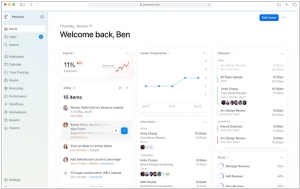Boomi vs Jitterbit
October 03, 2024 | Author: Michael Stromann
14★
Dell Boomi allows you to connect any combination of Cloud, SaaS, or On-Premise applications with no appliances, no software, and no coding. With Boomi you will achieve unprecedented implementation speeds that are just not possible with software packages, hardware appliances, or custom coding. Using only your web browser, you can sign up, log in and then build and deploy your integrations at whatever pace you require.
12★
Jitterbit is the leading agile cloud integration solution for today's modern architecture, rapidly connecting any on-premise, Cloud, Social, and Mobile apps. Jitterbit is a graphical tool that allows for the transport and transformation between data types and sources, including web services, XML files, ODBC and JDBC databases, EDI files, flat and hierarchic file structures.
See also:
Top 10 Cloud Integration platforms
Top 10 Cloud Integration platforms
Boomi and Jitterbit are both rather prominent characters in the grand cosmic dance of integration platforms, each with its own peculiar flair, like two intergalactic hitchhikers hitching a ride on a slightly different spaceship.
Boomi, being an offshoot of Dell Technologies—let’s think of it as a shiny, well-oiled, cloud-native, multi-tentacled beast—thrives on connecting applications, data sources and APIs with all the elegance of a Vogon poetry recital (but, you know, actually useful). It offers a unified platform, which is simply a fancy way of saying it’s the kind of thing that integrates applications across hybrid IT environments, stitching together the cloud and on-premises as if it were darning a sock. And, oh joy, it’s easy to use! With a delightful visual interface and pre-built connectors, even the least tech-savvy lifeform in the galaxy can deploy and scale integrations without writing so much as a single line of code—perfect for those whose idea of coding involves putting the kettle on.
Jitterbit, meanwhile, sits in the opposing corner of the integration cosmos, sipping its tea in a somewhat more customizable manner. It too offers a low-code platform, but where Boomi is all about simplicity and rapid deployment, Jitterbit delights in flexibility, agility and complexity. Picture it as a mildly eccentric, possibly genius, inventor who insists on doing things with a bit more flair. Jitterbit’s strength lies in its ability to tackle complex data transformations and workflows across cloud and on-premises systems, all while looking rather dashing in its low-code, high-flexibility cape. It’s perfect for organizations that, like Zaphod Beeblebrox, need to go fast but still want to take the scenic route while doing so.
See also: Top 10 Cloud Integration platforms
Boomi, being an offshoot of Dell Technologies—let’s think of it as a shiny, well-oiled, cloud-native, multi-tentacled beast—thrives on connecting applications, data sources and APIs with all the elegance of a Vogon poetry recital (but, you know, actually useful). It offers a unified platform, which is simply a fancy way of saying it’s the kind of thing that integrates applications across hybrid IT environments, stitching together the cloud and on-premises as if it were darning a sock. And, oh joy, it’s easy to use! With a delightful visual interface and pre-built connectors, even the least tech-savvy lifeform in the galaxy can deploy and scale integrations without writing so much as a single line of code—perfect for those whose idea of coding involves putting the kettle on.
Jitterbit, meanwhile, sits in the opposing corner of the integration cosmos, sipping its tea in a somewhat more customizable manner. It too offers a low-code platform, but where Boomi is all about simplicity and rapid deployment, Jitterbit delights in flexibility, agility and complexity. Picture it as a mildly eccentric, possibly genius, inventor who insists on doing things with a bit more flair. Jitterbit’s strength lies in its ability to tackle complex data transformations and workflows across cloud and on-premises systems, all while looking rather dashing in its low-code, high-flexibility cape. It’s perfect for organizations that, like Zaphod Beeblebrox, need to go fast but still want to take the scenic route while doing so.
See also: Top 10 Cloud Integration platforms





